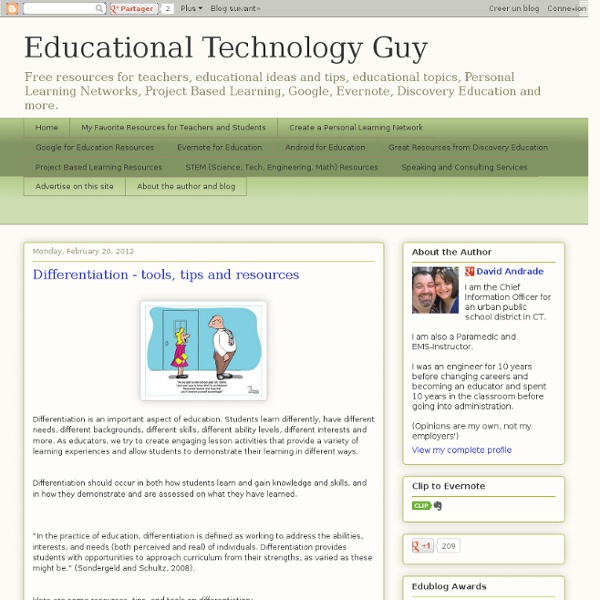Using Digital Tools for Differentiation
Direct Address to this Page: Anyone who has worked in education for any length of time knows just how important it is for teachers to create differentiated classrooms. If schools are truly working to ensure success for every student, learning experiences need to be customized and aligned to student interests, needs, and unique learning styles. The challenge, however, rests in making differentiation manageable. While few teachers doubt the importance of differentiating, many struggle to make customized learning spaces a reality. In this February 2012 Alaska Staff Development Network webinar, sixth grade classroom teacher, blogger and educational technology author Bill Ferriter will introduce participants to a range of digital tools that can be used to (1). provide structure for differentiated classrooms and (2). differentiate learning experiences by student interest.
The Best Resources On Differentiating Instruction
My colleague Katie Hull-Sypnieski is leading a February 1st Education Week Webinar on differentiating instruction, and I would strongly encourage people to participate. Katie’s the best teacher I’ve ever seen…. In addition, Katie and I have co-authored a piece for Education Week Teacher on the topic that will be appearing there soon (it’s appeared: The Five By Five Approach To Differentiation Success), and an upcoming post in my blog there will be talking about it, too (that two part series has also appeared).
Create a teacher site using Google Sites in five steps
Google Sites is possibly the easiest way to quickly share information online. This platform also makes collaboration a simple and natural part of the process of creating a website, making Google Sites an ideal fit for any classroom, PLC, administration team, or grade level partnerships. Getting started with Google Sites is a breeze, and you can have a fully functioning site going in just minutes. I have worked with many teachers on setting up their own classroom portals with Google Sites. Each teacher has different needs and therefore each one created a very different final product, but I think I’ve boiled the basic process down into five easy-to-follow steps.
Introduction to Cooperative Learning
An Overview Of Cooperative Learning David W Johnson and Roger T Johnson Without the cooperation of its members society cannot survive, and the society of man has survived because the cooperativeness of its members made survival possible….
Digital Differentiation
Technology is a tool that can be used to help teachers facilitate learning experiences that address the diverse learning needs of all students and help them develop 21st Century Skills. At it's most basic level, digital tools can be used to help students find, understand and use information. When combined with student-driven learning experiences fueled by Essential Questions offering flexible learning paths, it can be the ticket to success.
Teaching the Gifted and Talented: 33 Websites Where You Can Find Good Resources
I wish the Internet was available to me as a kid in elementary school. In New York City, where I attended kindergarten through sixth grade, they called the gifted and talented class "SP". I remember being put into a class to learn French, but very little else. I figured out how ahead I was only when I entered junior high school in New Jersey. The French language I had studied for three years allowed me to coast through French class for the next four years. Without anymore "SP" or "G and T" classes, I unfortunately developed a lazy attitude and eventually quit taking French in eleventh grade.
Using Technology to Differentiate Instruction - TheApple.com
Resources >> Browse Articles >> Utilizing Technology Featured Author: Mrs. Kelly Tenkely Kelly Tenkely is a technology teacher in a private school. Kelly also trains teaching staff on integrating and implementing technology into the classroom.
Powerful tool for creating web surveys. Online survey software made easy!
SurveyMonkey™ Thanks for completing this survey.Now create your own—it's free, quick & easy! Create free surveys in just a few minutes Ask questions in over 15 formats(configured for you and ready to go!) Get answers to any type of question Register with SurveyMonkey today! Sign Up FREE »



